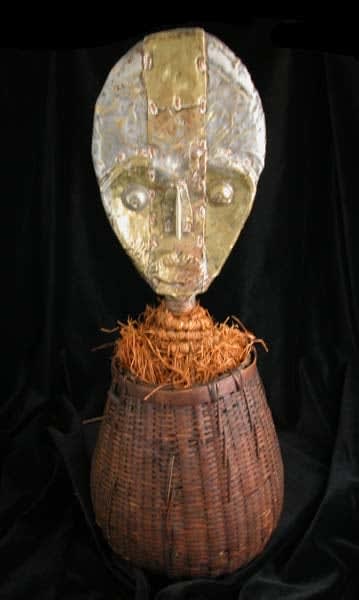Kota Wicker Reliquary and Guardian Figure, 20th Century CE
Brass Plated Wood
19.75
PF.6252 (LSO)
This remarkable object, a basket with a deconstructed anthropomorphic figure emerging from within, is a reliquary assemblage made by the Kota people of Gabon. It is a gourd-shaped basket, the...
This remarkable object, a basket with a deconstructed anthropomorphic figure emerging from within, is a reliquary assemblage made by the Kota people of Gabon. It is a gourd-shaped basket, the opening of which is partially blocked with raffia and the slim neck of the central figure. The face is high and domed, with the widest point across the temples, and is completely covered in sheet brass. There is a long strip connecting the forehead and the chin, and the details of the nose and mouth are embossed into it. The eyes are round and domed. Detail is otherwise limited.
The Kota live in Eastern Gabon, and are comprised of various subunits including Ndambomo, Mahongwe, Ikota-la-hua, Sake, Menzambi and Bougom, some of which can also be differentiated artistically (see below). Their society is largely egalitarian and gerontocratic, their economy based upon hunting and agriculture. Their relaxed social structure reflects their previous mobility – they moved into the area from the North during the 18th century – which is also perhaps the cause behind their unusual mortuary rituals in which they were basically able to take their ancestors with them wherever they went. It is also reflected in the comparatively small number of large items in their cultural repertoire, as transporting unwieldy items would have posed logistical problems.
The Kota originally exposed their dead, but started to bury them following influence from neighbouring groups. The remains (especially skulls) of prominent personages were then exhumed and placed into baskets (Bwete), which were defended by carved figures decorated with metal plates or wire. These figures diversified according to the geographical distribution of the subgroups, and together they are among the most famous and recognisable symbols of African art. Their radical deconstructivism of the human form had an enormous influence on the 20th century development of Western art styles, and exert a powerful fascination to historians of African art.
There are six forms, based around the proportions of the face, the nature of the wire/plate metal and the superstructures, such as headpieces or superfluous decoration. By being covered primarily with strips of brass (probably originally cut from colonial food plates), with round, domed eyes and a simplified face shape, it most probably belongs to the Shamaye style. According to some sources, baskets such as this were often furnished with a large and small guardian, the former representing the ancestor, the smaller his descendents. Almost all Kota pieces are rare as many traditional practices – including masquerades and the reliquary system – have been either suppressed or have gone out of fashion. To compound matters, many older items were intentionally destroyed in the 1940’s to 1960’s by the “Culte de Demoiselles”, who went out of their way to destroy traditional culture in an attempt to mimic western lifestyles.
This is a dramatic and impressive piece of African art.
The Kota live in Eastern Gabon, and are comprised of various subunits including Ndambomo, Mahongwe, Ikota-la-hua, Sake, Menzambi and Bougom, some of which can also be differentiated artistically (see below). Their society is largely egalitarian and gerontocratic, their economy based upon hunting and agriculture. Their relaxed social structure reflects their previous mobility – they moved into the area from the North during the 18th century – which is also perhaps the cause behind their unusual mortuary rituals in which they were basically able to take their ancestors with them wherever they went. It is also reflected in the comparatively small number of large items in their cultural repertoire, as transporting unwieldy items would have posed logistical problems.
The Kota originally exposed their dead, but started to bury them following influence from neighbouring groups. The remains (especially skulls) of prominent personages were then exhumed and placed into baskets (Bwete), which were defended by carved figures decorated with metal plates or wire. These figures diversified according to the geographical distribution of the subgroups, and together they are among the most famous and recognisable symbols of African art. Their radical deconstructivism of the human form had an enormous influence on the 20th century development of Western art styles, and exert a powerful fascination to historians of African art.
There are six forms, based around the proportions of the face, the nature of the wire/plate metal and the superstructures, such as headpieces or superfluous decoration. By being covered primarily with strips of brass (probably originally cut from colonial food plates), with round, domed eyes and a simplified face shape, it most probably belongs to the Shamaye style. According to some sources, baskets such as this were often furnished with a large and small guardian, the former representing the ancestor, the smaller his descendents. Almost all Kota pieces are rare as many traditional practices – including masquerades and the reliquary system – have been either suppressed or have gone out of fashion. To compound matters, many older items were intentionally destroyed in the 1940’s to 1960’s by the “Culte de Demoiselles”, who went out of their way to destroy traditional culture in an attempt to mimic western lifestyles.
This is a dramatic and impressive piece of African art.



